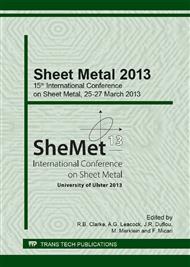p.141
p.149
p.156
p.164
p.172
p.180
p.189
p.197
p.205
Numerical Modeling of Tube Hydropiercing Using Phenomenological and Micro-Mechanical Damage Criteria
Abstract:
Hydropiercing is an efficient way of piercing holes in mass produced hydroformed parts with complex geometries. By driving piercing punches radially into a hydroformed and fully pressurized tube, holes will be pierced and extruded into the tube-wall. Recent experimental studies have shown that the formability of advanced high strength steel (AHSS) tubes can be increased with the application of internal pressure. In this study, three-dimensional finite element simulations of a tube hydropiercing process of a dual phase steel (DP600) were performed in LS-DYNA, using phenomenological, micromechanical and combined damage criteria. Damage was included in the numerical analysis by applying constant equivalent plastic strain (CEPS), the Gurson-Tvergaard-Needleman (GTN), and the Extended GTN (GTN+JC) model. In order to calibrate the parameters in each model, a specialized hole-piercing fixture was designed and piercing tests were carried out on non-pressurized tube specimens. Of the various ductile fracture criteria, the results predicted with the GTN+JC model, such as the punch load-displacement, the roll-over depth, and the quality of the clearance zone correlated the best with the experimental data.
Info:
Periodical:
Pages:
172-179
Citation:
Online since:
April 2013
Authors:
Price:
Сopyright:
© 2013 Trans Tech Publications Ltd. All Rights Reserved
Share:
Citation:


